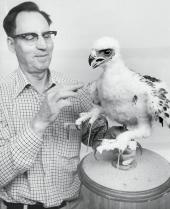
Fred Lahrman worked for fifty-five years at the Royal Saskatchewan Museum in Regina as a wildlife artist and conservationist. Lahrman was born on September 4, 1921, at Mortlach, Saskatchewan and grew up south of the town in the Missouri Coteau. He developed an interest and appreciation of nature and began sketching Birds and animals at an early age.
In 1946, Lahrman moved to Regina to pursue his art career. He was hired to do wildlife paintings at the Natural History Museum in 1947. For the next 55 years, Lahrman painted dozens of world-class background display dioramas for the exhibits at the Saskatchewan Museum of Natural History, later renamed the Royal Saskatchewan Museum. Lahrman's career included taxidermy, bird banding, wildlife photography, writing articles, doing illustrations for museum booklets and special publications of the Saskatchewan Natural History Society, and setting up the first interpretive displays in Provincial Parks.
Lahrman worked with longtime museum director, the late Fred G. Bard, in establishing the Wascana Canada Goose Flock in the early 1950s. They were also leaders in conserving the endangered whooping crane through public education and by working with other jurisdictions along the migration flyway, bringing North America's tallest bird back from the brink of extinction. Recognized nationally and internationally for his artistic ability and Conservation work, Lahrman left a legacy of lifelike dioramas at the Royal Saskatchewan Museum for future generations to observe and appreciate. He died in Regina on June 29, 2003.
Lorne Scott
Print EntryHOME | BROWSE BY SUBJECT | ENTRY LIST (A-Z) | IMAGE INDEX | CONTRIBUTOR INDEX | ABOUT THE ENCYCLOPEDIA | SPONSORS TERMS OF USE | COPYRIGHT © 2006 CANADIAN PLAINS RESEARCH CENTER, UNIVERSITY OF REGINA | POWERED BY MERCURY CMS |
|||
| This web site was produced with financial assistance provided by Western Economic Diversification Canada and the Government of Saskatchewan. |
|||
 |
 |
 |
 |
| Ce site Web a été conçu grâce à l'aide financière de Diversification de l'économie de l'Ouest Canada et le gouvernement de la Saskatchewan. |
|||